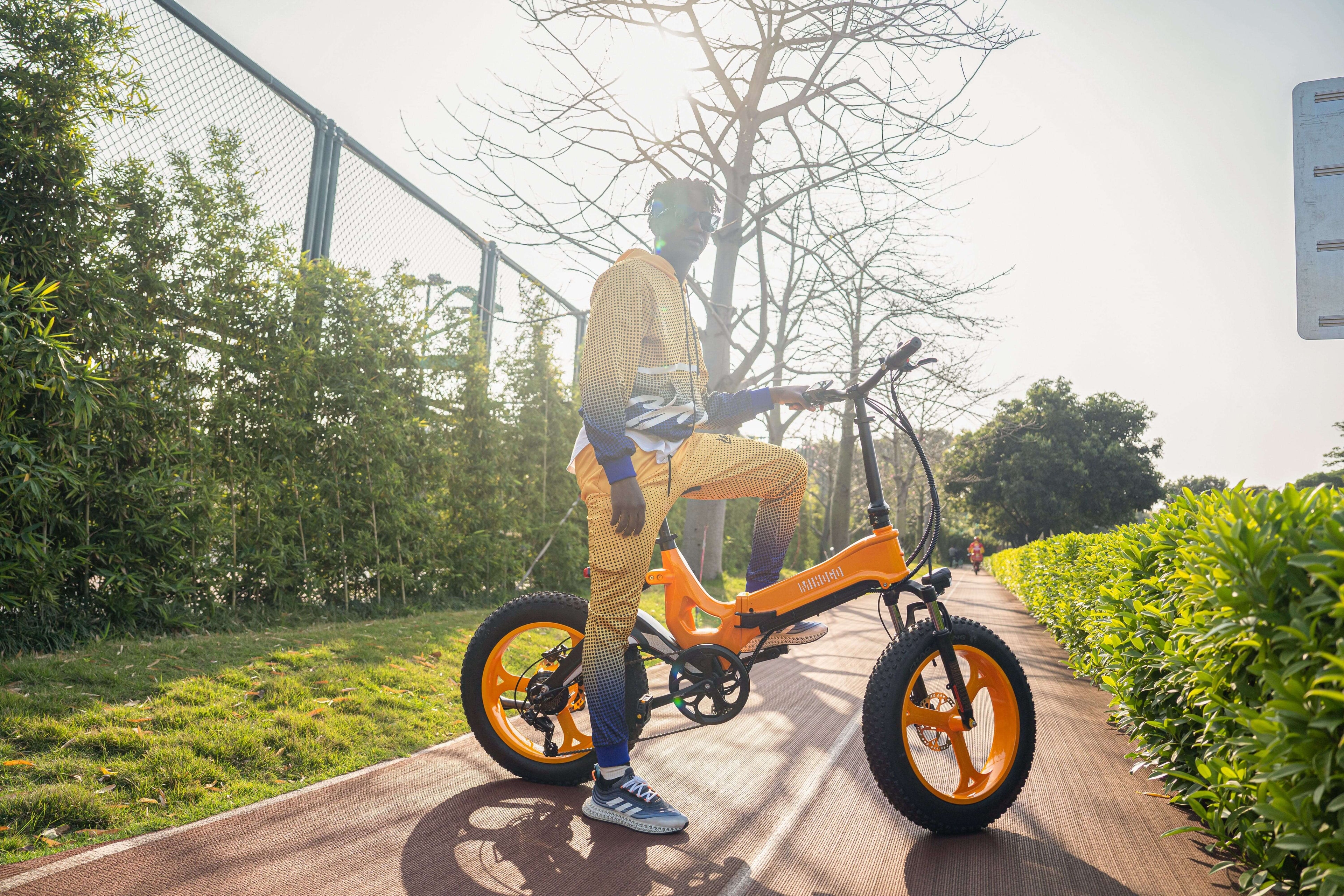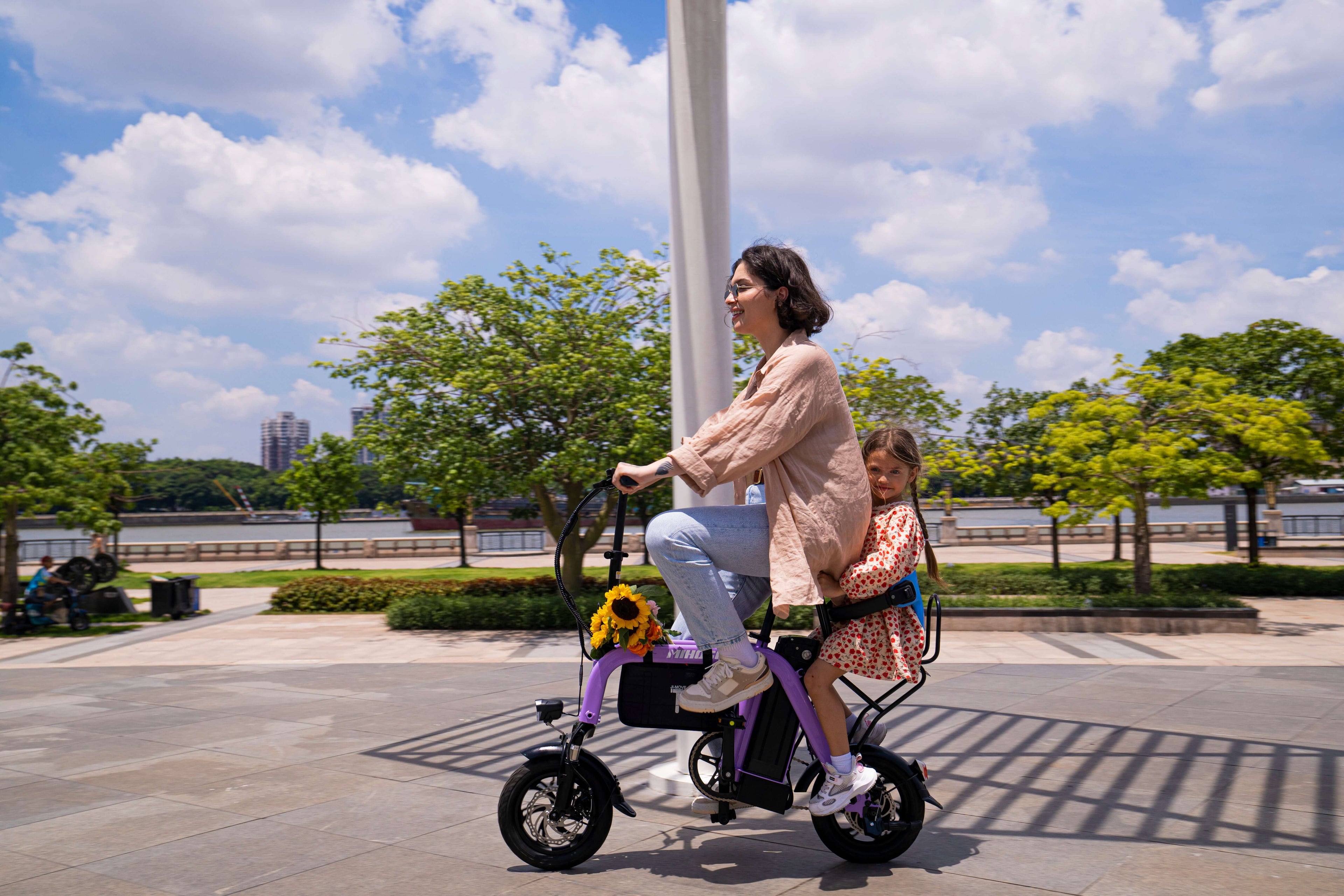Understanding E-Bike Brake Pad Wear Patterns
E-bike brake pads typically last between 500 to 3,000 miles, but this varies significantly based on riding conditions and e-bike specifications. For Mihogo riders, the increased weight and power of electric bikes means brake pads work harder than traditional bicycle brakes. The Air750 Max's impressive 121-mile range capability means extended riding sessions that put additional demands on braking systems, while the utility-focused ONE eBike's 167-mile range requires consistent brake performance for longer journeys.
Key Factors Affecting Brake Pad Lifespan on Mihogo E-Bikes
Motor Power Impact: Higher-powered models like the 750W Mihogo Air750 Max and ONE Utility eBike generate more speed and momentum, requiring more frequent braking and increased pad wear. The 500W RX 2.4 folding bike and 350W Mini experience moderate wear patterns suitable for urban commuting.
Riding Terrain: Hilly terrain accelerates brake pad wear significantly. If you frequently ride steep inclines with your Mihogo e-bike, expect to replace pads every 500-1,000 miles rather than the typical 1,500-2,000 miles on flat terrain.
Weather Conditions: Wet and muddy conditions increase brake pad wear by up to 40%. Regular cleaning and inspection become essential for maintaining optimal braking performance across all Mihogo models.
Visual and Performance Signs for Brake Pad Replacement
Critical Warning Signs You Cannot Ignore
Thickness Measurement: Most disc brake pads should maintain at least 1.5mm of material. When pads wear below this threshold, replacement becomes urgent for safety reasons. Check pads every 500 miles or monthly for high-usage riders.
Squealing and Grinding Noises: Initial squealing often indicates contamination or wear indicators, while grinding sounds mean pads have worn completely, causing metal-to-metal contact with rotors. This can damage expensive brake rotors and compromise safety.
Reduced Braking Power: If your Mihogo e-bike requires longer stopping distances or more lever pressure, this indicates worn pads that need immediate replacement. This is particularly dangerous given the higher speeds possible with electric assistance.
Visual Wear Indicators: Look for uneven wear patterns, glazing (shiny surface), or chunks missing from brake pad material. Any of these conditions warrant immediate replacement regardless of pad thickness.
For comprehensive brake system information, reference the Bicycle Brake Systems Guide on technical specifications and safety standards.
Model-Specific Brake Maintenance for Mihogo E-Bikes
Mihogo Air750 Max (Carbon Fiber, 750W, 121 Miles)
This high-performance model demands premium brake pad materials capable of handling sustained high-speed braking. With its carbon fiber construction and powerful motor, expect brake pad replacement every 800-1,200 miles under normal conditions. The extended range capability means longer rides that generate more heat, requiring pads with superior heat dissipation properties.
Recommended Inspection Schedule: Every 400 miles or monthly Expected Replacement Interval: 800-1,200 miles Special Considerations: Use metallic pads for better wet performance and heat management
Mihogo ONE Utility eBike (750W, 167 Miles)
The utility-focused design means this bike often carries cargo, increasing brake pad wear. The impressive 167-mile range suggests extended touring capability, making reliable brakes essential for safety during long-distance rides.
Recommended Inspection Schedule: Every 300 miles or bi-weekly for heavy cargo use Expected Replacement Interval: 600-1,000 miles Special Considerations: Consider upgrading to hydraulic disc brakes for consistent performance under load
Mihogo RX 2.4 (Folding, 500W, 40 Miles)
This commuter-focused folding bike experiences moderate brake wear due to its 500W motor and urban riding profile. The 40-mile range suits daily commuting with predictable brake pad wear patterns.
Recommended Inspection Schedule: Every 500 miles or monthly Expected Replacement Interval: 1,000-1,500 miles Special Considerations: Ensure pads remain compatible with folding mechanism clearances
Mihogo Mini (350W, 62 Miles)
The Mini's lower power output and urban focus result in the most predictable brake pad wear among Mihogo models. However, city riding with frequent stops can accelerate wear through constant brake engagement.
Recommended Inspection Schedule: Every 600 miles or monthly Expected Replacement Interval: 1,200-2,000 miles Special Considerations: Prioritize organic pads for quieter urban operation
Professional Brake Pad Replacement Process
Essential Tools and Safety Preparations
Before beginning brake pad replacement on your Mihogo e-bike, gather proper tools including 5mm Allen keys, needle-nose pliers, clean rags, and isopropyl alcohol. Always turn off your e-bike, remove the battery, and discharge remaining power by holding the mode button.
Step-by-Step Replacement Procedure
Safety First: Wear protective gloves to prevent contamination of new brake pads with skin oils, which can reduce braking performance. Work in a well-ventilated area when using cleaning agents.
Wheel Removal: Carefully remove the wheel to access brake calipers. For rear wheels on hub motor models, loosen axle bolts rather than fully removing the wheel to avoid disconnecting motor cables.
Caliper Access: Remove brake caliper mounting bolts using appropriate Allen keys. Take photos before disassembly to ensure proper reassembly alignment.
Pad Extraction: Remove the cotter pin or retaining clip securing brake pads. Use needle-nose pliers to straighten bent retention pins, then push pads out of caliper housing.
Cleaning and Inspection: Clean caliper housing with isopropyl alcohol, inspecting for damage or excessive wear. Check brake rotors for scoring, warping, or contamination.
New Pad Installation: Install new pads ensuring proper alignment with rotor surface. Never touch braking surfaces with bare hands, as skin oils reduce performance.
System Reassembly: Replace retention pins, reinstall caliper, and mount wheel. Test brake lever feel before riding, ensuring proper pad-to-rotor clearance.
For detailed brake maintenance procedures, consult the International Cycling Union's technical standards for professional guidelines.
Brake Pad Material Selection for Mihogo Models
Organic vs. Metallic Brake Pads
Organic Pads: Offer quiet operation and smooth initial bite, making them ideal for the Mihogo Mini's urban environment. However, they wear faster under the high-performance demands of 750W models like the Air750 Max and ONE Utility eBike.
Metallic Pads: Provide superior durability and wet-weather performance essential for high-powered Mihogo models. While potentially noisier, they handle heat better and last longer under demanding conditions.
Semi-Metallic Options: Offer balanced performance suitable for the RX 2.4's commuter profile, providing good wear characteristics with acceptable noise levels.
Preventive Maintenance Between Replacements
Regular Inspection Protocols
Implement monthly visual inspections regardless of mileage, checking for contamination, uneven wear, or damage. Clean brake rotors regularly with isopropyl alcohol to maintain optimal performance and extend pad life.
Riding Techniques to Extend Pad Life
Progressive Braking: Gradually apply brakes rather than sudden hard stops to reduce heat buildup and pad wear. This technique is particularly important for high-powered models like the Air750 Max.
Engine Braking: Utilize regenerative braking features when available, reducing reliance on friction brakes during normal riding conditions.
Proper Storage: Store your Mihogo e-bike in dry conditions to prevent brake system contamination and corrosion that accelerates pad wear.
Learn more about cycling maintenance best practices from the League of American Bicyclists safety resources.
Cost-Effective Brake Maintenance Strategies
DIY vs. Professional Service
Basic brake pad replacement can be performed by most Mihogo owners with proper tools and guidance. However, hydraulic brake systems or complex adjustments may require professional service to ensure safety and warranty compliance.
Bulk Purchasing and Seasonal Preparation
Consider purchasing brake pads in sets during seasonal sales, ensuring you have replacements available when needed. This prevents downtime and ensures consistent pad material across your brake system.
[Internal: Seasonal Maintenance Checklist]
Develop comprehensive seasonal maintenance routines that include brake inspections alongside battery care and drivetrain maintenance. This proactive approach prevents emergency repairs and extends component life.
Advanced Brake System Upgrades
Hydraulic Brake Conversion Benefits
For high-mileage Mihogo riders, upgrading from mechanical to hydraulic disc brakes offers improved performance, reduced maintenance frequency, and better modulation. This upgrade particularly benefits the Air750 Max and ONE Utility models that see extended use.
Performance Brake Rotor Options
Larger rotors provide better heat dissipation and stopping power, especially beneficial for the 750W Mihogo models. Consider 180mm or 203mm rotors for improved performance under load.
[Internal: Brake System Upgrade Guide]
Future upgrades can include features like regenerative braking integration, which reduces pad wear while extending battery range—particularly valuable for long-range models like the ONE Utility eBike.
Troubleshooting Common Brake Issues
Solving Brake Fade Problems
Brake fade occurs when pads overheat during extended braking, reducing effectiveness. This particularly affects riders using the Air750 Max's full range capability on hilly terrain. Solutions include upgrading to metallic pads and ensuring proper rotor cooling.
Addressing Contamination Issues
Oil contamination from chain lubricants or environmental sources ruins brake pads requiring immediate replacement. Prevent contamination through careful maintenance practices and proper storage.
Noise Reduction Techniques
Brake squealing often results from contamination, improper break-in procedures, or pad material incompatibility. Address through proper cleaning, bedding-in new pads, and selecting appropriate pad materials for your riding conditions.
Seasonal Brake Maintenance Considerations
Winter Preparation for Mihogo E-Bikes
Cold weather affects brake performance, requiring more frequent inspections and potential pad material changes. Salt exposure accelerates wear and requires immediate post-ride cleaning to prevent damage.
Summer Heat Management
High temperatures during extended rides can cause brake fade, particularly on powerful models like the Air750 Max. Consider heat-resistant pad compounds and ensure adequate cooling during long rides.
Emergency Brake Replacement Situations
Recognizing Critical Failure Signs
Complete brake pad wear creates dangerous situations requiring immediate attention. Never ride with grinding brakes or significantly reduced stopping power, regardless of convenience factors.
Temporary Solutions and Professional Help
If brake failure occurs away from home, seek immediate professional assistance. Temporary fixes like cable adjustments may provide limited functionality but never replace proper brake pad replacement.
Building Emergency Preparedness
Carry basic tools and know the location of nearby bike shops when planning extended rides with your Mihogo e-bike. This preparation becomes crucial for long-range models capable of extensive touring.
Future-Proofing Your Mihogo Brake System
Technology Integration Trends
Advanced brake systems increasingly integrate with e-bike electronics, providing wear monitoring and maintenance alerts. Consider compatibility when selecting replacement components for long-term ownership.
Sustainable Maintenance Practices
Choose recyclable brake pad materials and proper disposal methods for worn components. Many manufacturers now offer take-back programs for used brake parts.
Performance Monitoring Systems
Smart brake systems that monitor pad wear and performance are becoming available, particularly valuable for high-mileage riders using the Air750 Max or ONE Utility models extensively.
Conclusion: Prioritizing Safety Through Proper Brake Maintenance
Maintaining optimal brake performance on your Mihogo e-bike requires understanding model-specific demands, regular inspection schedules, and timely replacement when wear indicators appear. The powerful motors and extended ranges of Mihogo models make reliable braking systems essential for safe riding experiences.
From the urban-focused Mihogo Mini requiring pads every 1,200-2,000 miles to the high-performance Air750 Max needing replacement every 800-1,200 miles, each model presents unique maintenance requirements. Regular inspection every 500 miles, regardless of model, ensures early detection of wear before safety becomes compromised.
Remember that brake pad replacement is not just maintenance—it's an investment in rider safety and e-bike longevity. Quality pads appropriate for your riding style and Mihogo model specifications provide consistent performance while protecting expensive brake rotors from damage.
Ready to maintain your Mihogo e-bike's brake system? Regular inspection and timely replacement ensure safe, confident riding across all terrains and conditions. Don't wait for warning signs—proactive maintenance keeps you riding safely mile after mile.








